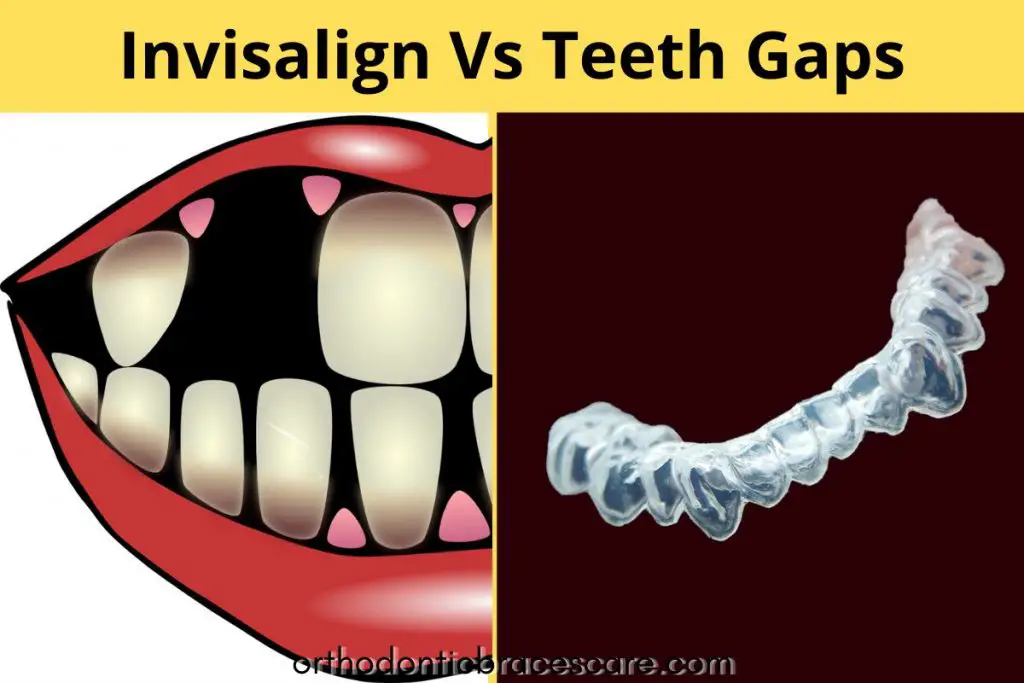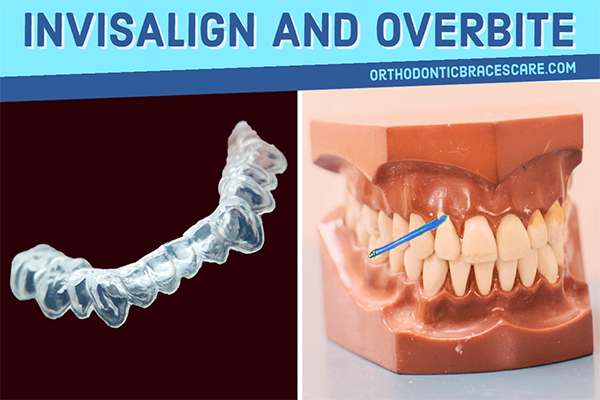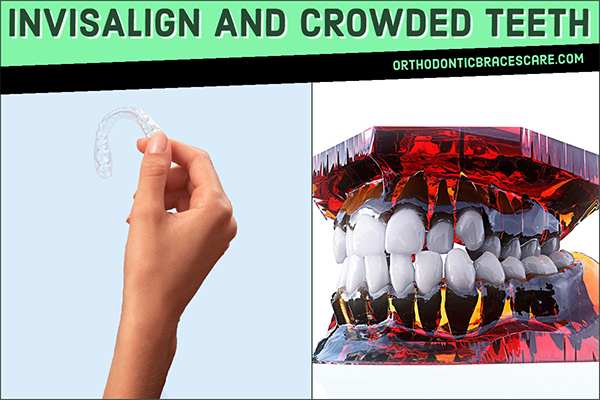If you have large or missing teeth gaps, or if you need a tooth extraction for orthodontic treatment, you must want to know, “Can Invisalign close teeth gaps?”
Invisalign clear aligner closed any types of gaps within 6 mm by putting pressure on the teeth and creating an ideal tooth movement. Depending on the cause and size of the gap, it may or may not be able to fix the large gap left by missing teeth. If your teeth are extracted to align teeth, it can also close the gaps left by the teeth.
However, clear aligners cannot close gaps wider than 6 mm.
But, if the cause of the missing tooth isn’t for tooth alignment purposes, you need other treatment options such as a crown, bridge, or dental implant.
Moreover, there are some orthodontic cases when clear aligners may not be helpful.
You may wonder, what are the factors that determine if the gaps can be closed using a clear aligner like Invisalign?
Let’s find it out.
Types of gaps that Invisalign can fix

You may have gaps between teeth due to many causes. Let’s know when Invisalign can close the gaps.
Generalized spacing between teeth
Invisalign clear aligners can effectively close gaps when you have generalized spacing or spacing between the majority of your teeth.
These types of spacings are genetic. It might happen because your arch or jaw has too much room compared to the size of your teeth.
Small to medium teeth gaps
You can easily close small to medium gaps between teeth using the Invisalign system. It makes no difference if the space is between two or more teeth; that is not the issue.
Gaps in front teeth
It might not be attractive to have a gap between your front teeth. The good news is that the aligner can help you fix that and get straight teeth.
A habit, an extra tooth between the teeth, or abnormal frenal tissue located between the teeth could be to responsible for this gap.
Missing teeth from childhood
Some people have lost a tooth since they were children. It might not even erupt at all or it might be kept under the gums. Also, some people lost their teeth long ago for various reasons.
These conditions result in crowded teeth or an overbite as well as uneven tooth alignment. Invisalign can help you correct all of these issues caused by the missing teeth.
After the extraction of extra teeth
It is necessary to have a supernumerary tooth, or extra tooth, extracted before getting treatment.
Therefore, a gap is formed between your teeth. But that’s nothing to be worried about. After treatment, the clear aligner fills in the gaps and offers you a stunning smile.
Wisdom tooth gaps
It is better to remove wisdom teeth if they are positioned incorrectly or are creating any complications. It can be necessary to extract them during orthodontic treatment.
If there are gaps, Invisalign can be successful because its removal won’t cause any functional issues.
Gaps due to habits
Kids who indulge in bad oral habits like thumbsucking and tongue thrusting put a lot of pressure on their teeth.
Because of this, the teeth become out of alignment and develop a number of issues, including gaps between the front teeth. In that case, a clear aligner can completely close the gap. However, they must give up the behavior.
Some tooth extraction cases
Tooth extraction is required when there is not enough room in your jaw to move your teeth so they are properly aligned.
Because of the emergence of several attachments, Invisalign is able to correct some of those problems.
Gaps after braces treatment
Rarely, after braces treatment, small-sized gaps may persist or the previous gap may return. If so, Invisalign is an option to close the gaps.
Learn more about gaps in teeth after braces.
Types of gaps that Invisalign can’t fix
Here are the cases when Invisalign can’t close the gaps between teeth.
Severe tooth extraction cases
We need space in the arch to correct crowded or misaligned teeth. Before beginning orthodontic treatment, it may occasionally be necessary to remove two to four teeth. In some circumstances,
Invisalign might not function as well as braces. The greatest option for treating those issues, in my opinion, is still braces treatment.
Missing tooth due to an injury
You should see an oral and maxillofacial surgeon if you lose a tooth as a result of an accident. A clear aligner isn’t suitable for the case.
Tooth removal for purposes other than tooth alignment
Sometimes you may have one or more teeth extracted due to tooth decay, gum disease, or other dental condition.
Besides, you may or may not have misaligned or crooked teeth. In those cases, Invisalign is not the option.
Too large gaps
The clear aligner might not be useful when the gap is significant, especially if it is greater than 6 mm.
Additionally, it might not be useful in some extraction cases where several teeth need to be removed and there are multiple gaps.
Other options, such as a dental implant, crown, or bridge, are required if the gap is caused by an accident or another oral issue.
How does Invisalign close gaps?
During Invisalign treatment to close gaps between teeth, you get many sets of Invisalign trays. Each set of trays is designed to put pressure on your teeth to close the gaps gradually.
When the pressure is applied, changes occur within the bone. This allows teeth to move towards the gap and close it completely.
One set of trays can’t close the gap completely. So, every one to two weeks, you receive a new set of aligners.
All gaps eventually close as time passes. The aim of the Invisalign procedure is not just to close the gaps, though.
Even if the spaces between your teeth are closed, the bite must also be corrected, affecting the function of your teeth and jaws. Moreover, teeth may return to their original position over time.
Who can get help from Invisalign to close the gaps?
If the case meets all of the requirements, both children and adults may have Invisalign treatment to close gaps between teeth. To have a better outcome and faster result, it’s preferable to treat the problem at a young age.
How long does Invisalign take to close gaps?
Invisalign may take anywhere from 3 to 12 months to close gaps between teeth. Moreover, it may take up to 18-24 months to correct all problems and complete the treatment. However, the duration depends on the number and size of gaps, the complexity of cases, the age of the patient, and other factors.
You get many Invisalign trays in the course of treatment. One aligner can move teeth to 0.2 mm. You get a new set of trays every one or two weeks.
Suppose, you have 2 mm gaps between the teeth. So, it may take three to three and a half months to close the gap.
But, keep in mind that it varies from case to case. The young patient may get a quicker result than the adult. Moreover, Simple cases need less time than complicated cases.
Why should you get Invisalign to close gaps?
Get Invisalign to close gaps if you don’t want to wear those unpleasant metal braces. To close gaps, clear aligners can be just as effective as braces.
Additionally, unlike braces, you don’t need to attach them to the teeth. You are always free to remove it.
The aligners for Invisalign are made of clear plastic. No one will realize that you are wearing the trays as a result.
The aligners are also very comfortable to use. So, you can choose Invisalign treatment to fix gaps if your case permits.
Can Invisalign fix gaps from missing teeth?
Invisalign can close missing teeth gaps after extraction that’s done to treat crooked teeth. It can also fix the missing tooth gap if the width of the gap is less than 6 mm. However, if you have a missing tooth due to a condition such as a tooth decay or trauma, you will need to replace it with a dental implant, a dental bridge, or other dental prostheses.
How long does Invisalign take to close a missing tooth gap?
If you have a gap from a missing tooth that’s less than 6 mm, Invisalign may take 3 to 12 months to close the gap. However, the gap should be favorable to treat with Invisalign.
Larger gaps or severe cases can be fixed with braces.
Why are my gaps not closing Invisalign?
There could be several reasons why your gaps are not closing with Invisalign.
One reason could be that the aligners are not being worn for the recommended 22 hours per day. Another reason could be that the gaps are too big for Invisalign to close.
If you have any questions or concerns about your Invisalign treatment, be sure to talk to your orthodontist.
Invisalign alternatives to Invisalign to close gaps
Here are the alternatives to Invisalign to close the gaps due to an orthodontic condition.
Braces
If your case is severe or Invisalign is not indicated, braces should be the best choice to close gaps. In fact, braces can fix any orthodontic problem easily and more effectively.
The brackets are glued to the teeth, and a wire is passed through them. The wire is tightened gradually, which puts pressure on the teeth and closes the gaps.
Dental veneers
If you have small gaps, your dentist may suggest dental veneers. Veneers are thin shells that are glued to the front of teeth.
This is a cosmetic treatment that can fix small gaps and spaces between teeth. Veneers are also used to improve the appearance of teeth that are chipped, stained, or misshapen.
Dental bonding
If you have small gaps or spaces between teeth, your dentist may suggest dental bonding. In this treatment, a tooth-colored resin is used to fill the gaps.
The resin is applied to the teeth and hardened with a special light. After that, it’s shaped and polished to match the rest of the tooth.
Dental bonding is a quick and easy way to fix small gaps between teeth. The results are not as permanent as veneers, though.
The bonding material may stain over time and need to be replaced.
Retainers
In mild cases such as single tooth gaps, children may have an active retainer to close the gaps. However, it can’t be effective as braces or Invisalign.
Dental Implant
A dental implant is a good alternative to Invisalign if you have gaps in your smile due to missing teeth.
A titanium screw is placed into the jawbone to act as a root. Then, an artificial tooth is placed on top of the screw. It looks and feels like a natural tooth.
But, it’s a bit expensive. So, you may want to consult your dentist to know whether you are a good candidate for dental implants.
Crowns or bridges
Another option is to get dental crowns or bridges. But it’s not a good choice if the gaps are due to an orthodontic problem.
Denture
If you have gaps in teeth due to missing teeth, dentures can be an option. It’s a removable appliance that fills in the gaps in your smile.
Dentures are made of plastic or porcelain teeth set in a gum-colored base. They look like natural teeth and can restore your smile.
But, they are not a good choice if you have gaps due to an orthodontic problem.
Check out my other article to know how to close teeth gaps without braces.
Takeaways
A gap that is less than 6 mm in size and caused by an orthodontic issue can be closed with Invisalign or clear aligners. If the gap is greater than 6 mm and there are other problems, such as skeletal issues, you might need braces and other forms of treatment.
FAQs about Invisalign for gaps
How fast does Invisalign close gaps?
In general, Invisalign can close a single gap in 3 to 9 months and multiple gaps in 12 months or more. Each aligner from Invisalign allows for a 0.2 mm movement. However, the speed of treatment depends on the severity of the case.
What size gap can Invisalign fix?
Invisalign can close gaps that are up to 6 mm wide. But, if the gaps are bigger than that, you might need braces or other forms of treatment.
How much does Invisalign cost for gaps?
The cost of Invisalign for gaps starts at $2,000. But, the final cost depends on the severity of the case and other factors.
Can Invisalign cover missing teeth?
Invisalign can’t cover missing teeth. But, you can close the gaps with Invisalign if the gaps are due to missing teeth and are suitable to treat the case with it.
Can I get Invisalign with a missing front tooth?
Even if your front tooth is missing, you can still get Invisalign to straighten your teeth. However, in order to replace the missing front tooth, you might need a dental implant or another type of dental prosthesis.
Can you have Invisalign with missing back teeth?
You can get Invisalign to align your teeth properly even if you have missing back teeth. But, after the end of your treatment, you might need to fix the molar tooth gap with a dental implant, bridge, or other dental prostheses.
Pallab Kishore is a certified dentist and the owner of Orthodontic Braces Care.
He completed BDS in 2014. Now, he is an MS resident in Orthodontics, BSMMU. He likes content writing and has 12+ years of experience in blogging.


